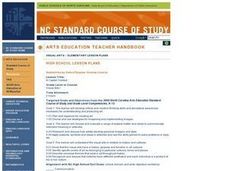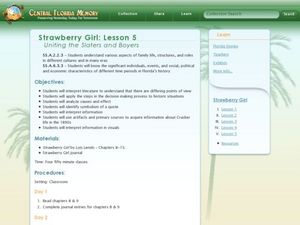Curated OER
"The Letters Are Lost"
Students listen to story, "The Letters Are Lost," by Lisa Campbell Ernst, identify letters of alphabet in group setting, practice writing their letters on writing tablet, choose letter, and identify items that begin with that letter of...
Curated OER
Where The Green Grass Grows
Students recognize the phoneme /g/. Through matching activities, students discriminate the phoneme /g/ from other letters and phonemes. They associate the phoneme /g/ with its letter representation and identify the phoneme /g/ in various...
Curated OER
Boo.....AAAaaaa!!!
Students complete a variety of activities related to the short /a/ sound. As a class they recite a tongue twister, then trace and write the letter A. Students then listen to word pairs and identify the word containing the short /a/...
Curated OER
The Creaky Door says /e/
Students explore the short /e/ sound, and identify the short /e/ in writing. Students read fun sentences from the board which emphasize the short /e/. They stretch out the /e/ sound every time they come to it while reading. They then...
Curated OER
Open Wide
First graders make the sound of /o/ relating it to the sound they make when the doctor asks them to open their mouth and say "ahhhh". They think of different words that contain the /o/ and identify it as it is used in a sentence and...
Curated OER
Batter's Up
Students recognize the short vowel a in written and spoken language. Through matching activities, they discriminate the short vowel /a/ from other vowel phonemes. Students associate the phoneme with its letter representation and identify...
Curated OER
Doc Says Open Up
Students recognize the short /o/ sound in spoken words in this lesson. They say a tongue twister with words emphasizing the short /o/ sound. They then listen the the book "Hop on Pop" by Dr. Suess, and identify the words they hear...
Curated OER
"Gazunheit!"
Students study the /a/ phoneme by determining how the mouth move when it makes the sound by imitating a sneeze. They recite a tongue twister, practice writing the lowercase "a" and listen to a story while identifying the letter sound....
Curated OER
Independent Novel Project
Students complete activities for an independent novel project. In this novel project worksheet, students follow the 13 steps to analyze and complete a comprehensive project about a novel they've read.
Curated OER
Icky Sticky!
Students recognize the short vowel i in written and spoken language. Through matching activities, they discriminate the short vowel /i/ from other vowel sounds. Students associate the phoneme with its letter representation and identify...
Curated OER
A Capital Contest
Students analyze Ghiberti's Gates of Paradise and the competition for their design in which Brunelleschi's design was refused. The instructional activity concludes with students creating new doors for the U.S. Capitol Building in...
Curated OER
Laugh at the Cat!
Students complete a variety of activities related to the short /a/ sound. As a class they recite a tongue twister, then trace and write the letter A. Students then play a concentration matching game, listen to the book "Cat Traps," and...
Curated OER
Slippery Sammy the Seal
Students examine the letter 's'. Through instruction and modeling they explore the sound the letter makes, how the letter is written, words that contain the letter, etc. They say tongue twisters with the /s/ sound in them. They read...
Curated OER
Purple Polly Platypus
First graders compare the /p/ sound to the sound of popcorn popping in the microwave and practice making the /p/. They try a tongue twister listening for the /p/ sound for the first time and then clapping when they hear the sound the...
Curated OER
Strawberry Girl: Lesson 5
Pupils read the book Strawberry Girl by Lois Lenski. For this literature lesson, students read chapters 8-15 and complete journal entries. They look at how life was in the 1890's.
Curated OER
Similes and Metaphors
Reward your class with tasty treats while teaching them about simile and metaphor. After a teacher demo and explanation of simile and metaphor, pupils read books, looking for examples of these literary devices and copying them down....
Curated OER
Mapping Perceptions of China
Learners discuss what types of things are included on a map. They compare and contrast maps of China with a map they create and practice using different types of maps. They write analysis of their classmates maps.
Curated OER
A Walk Around the School: Mapping Places Near and Far
After reading Pat Hutchins’ Rosie’s Walk, have your young cartographers create a map of Rosie’s walk. Then lead them on a walk around the school. When you return class members sequence the walk by making a list of how the class got from...
Curated OER
Dr. Heidegger's Experiment
Examine the idea of perpetual youth and immortality while you read Nathaniel Hawthorne's Dr. Heidegger's Experiment. Some links work to direct your learners to information about the Fountain of Youth. Using this information, scholars...
Curated OER
The ABC's of Walter Anderson
Fifth graders examine how motifs, symbols, and ideas influence various pieces of visual art. They compare and contrast the work of Walter Anderson to pre-historic cave paintings and create a glue line print using motifs and symbols found...
Curated OER
Indian "Buffalo Skin" Writing
Fifth graders identify common Native American writing symbols. They create paper bag "buffalo skins" and on the back, they write stories about Indian life.
Curated OER
W Is For Wyoming
Students engage in a lesson about the state of Wyoming. They complete a worksheet looking for facts and identify some common symbols used to represent the state. The symbols are used to practice sounds and give context to class discussion.
Curated OER
Hindu Gods Batik
Learners identify the major Hindu gods and describe the relationship between them. They examine symbols and determine their meanings. They create a batik of a Hindu god of their choice and research them.
Curated OER
Story Scrapbook
Pupils develop a comparison worksheet using one non fiction book and one fiction book they have read to be put into a class scrapbook. In their comparison students must have title, author, point of view, setting, characters, and other...

























